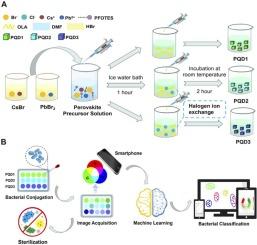使用水性 CsPbBr3 Perovskite 量子点的机器学习驱动型荧光传感器阵列,用于快速检测和杀灭食源性病原体
IF 12.2
1区 环境科学与生态学
Q1 ENGINEERING, ENVIRONMENTAL
引用次数: 0
摘要
随着全球对食品安全的日益关注,食源性病原体的快速检测和消毒已成为公共卫生的关键。本研究提出了一种新型的机器学习驱动荧光传感器阵列,利用水性 CsPbBr3 包晶量子点(PQDs)快速识别和消除食源性病原体。利用机器学习算法支持向量机(SVM)分析了传感器阵列产生的相对信号强度变化(ΔRGB)。该研究在 1.0×103 至 1.0×107 CFU/mL 的浓度范围内识别了五种病原体及其混合物,准确率达到 100%,并且发现病原体的检测限(LOD)很低。此外,该阵列在鉴定自来水中的病原体方面也表现出色,准确率达到 100%。此外,荧光传感器阵列还能在检测后 30 分钟内灭活病原体,灭活效率超过 99%。这项研发为食品安全检测领域提供了一种高效可靠的工具。本文章由计算机程序翻译,如有差异,请以英文原文为准。

Machine learning-driven fluorescent sensor array using aqueous CsPbBr3 perovskite quantum dots for rapid detection and sterilization of foodborne pathogens
With the growing global concern over food safety, the rapid detection and disinfection of foodborne pathogens have become critical in public health. This study presents a novel machine learning-driven fluorescent sensor array utilizing aqueous CsPbBr3 perovskite quantum dots (PQDs) for the rapid identification and eradication of foodborne pathogens. The relative signal intensity changes (ΔRGB) generated by the sensor array were analyzed using the machine learning algorithm—Support Vector Machine (SVM). The study achieved the identification and recognition of five pathogens and their mixtures within a concentration range of 1.0 × 103 to 1.0 × 107 CFU/mL with an accuracy rate of 100 %, and the limits of detection (LOD) for the pathogens were found to be low. Additionally, the array also showed excellent performance in the identification of pathogens in tap water, achieving an accuracy rate of 100 %. Furthermore, the fluorescent sensor array was capable of inactivating the pathogens with an efficiency of over 99 % within 30 min post-detection. This development provides an efficient and reliable tool for the field of food safety detection.
求助全文
通过发布文献求助,成功后即可免费获取论文全文。
去求助
来源期刊

Journal of Hazardous Materials
工程技术-工程:环境
CiteScore
25.40
自引率
5.90%
发文量
3059
审稿时长
58 days
期刊介绍:
The Journal of Hazardous Materials serves as a global platform for promoting cutting-edge research in the field of Environmental Science and Engineering. Our publication features a wide range of articles, including full-length research papers, review articles, and perspectives, with the aim of enhancing our understanding of the dangers and risks associated with various materials concerning public health and the environment. It is important to note that the term "environmental contaminants" refers specifically to substances that pose hazardous effects through contamination, while excluding those that do not have such impacts on the environment or human health. Moreover, we emphasize the distinction between wastes and hazardous materials in order to provide further clarity on the scope of the journal. We have a keen interest in exploring specific compounds and microbial agents that have adverse effects on the environment.
 求助内容:
求助内容: 应助结果提醒方式:
应助结果提醒方式:


